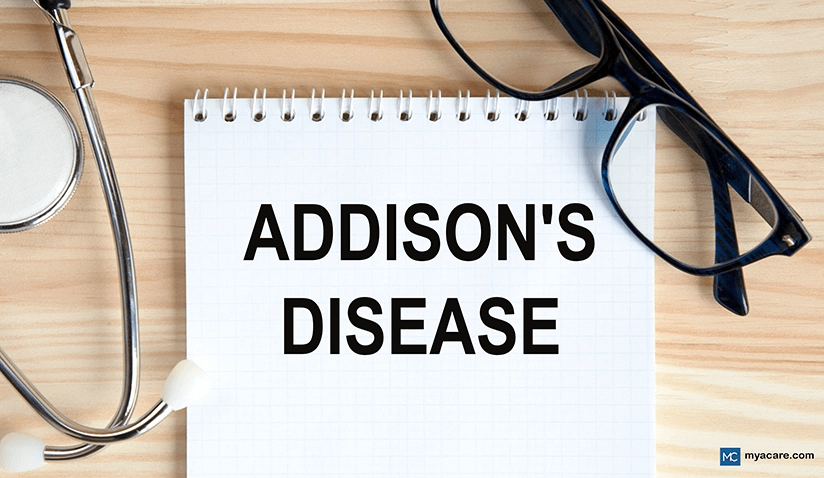What Is Addison’s Disease? Diagnosis and Treatment

When there is a problem with the adrenal glands not producing enough hormones, it is known as Addison's disease or primary adrenal insufficiency. Specifically, the glands do not make enough cortisol and aldosterone. Symptoms of Addison’s disease can be ambiguous and include lack of appetite, weight loss, weakness, and tiredness.
Primary adrenal insufficiency occurs when the adrenal cortex is damaged. Secondary adrenal insufficiency is different because it involves problems with the pituitary gland. Addison’s disease is not common but needs to be diagnosed and treated because it can result in life-threatening complications such as kidney failure and shock.
Who Treats Patients With Addison’s Disease?
Endocrinologists specialize in treating hormonal problems in the body. Hence, a person with Addison’s disease should consult a specialist from this department.
Diagnosis of Addison’s Disease
Various tests can diagnose Addison’s disease. These are described below.
- Blood tests: Serum cortisol level is abnormally low, at < 5 mcg/dL, and plasma ACTH is unusually high (≥ 50 pg/mL). ACTH is called adrenocorticotropic hormone, and it is released from the pituitary gland. ACTH is the hormone that stimulates the adrenal gland to secrete cortisol.
- Provocative test using ACTH: These tests are done to show the response of the adrenal gland to ACTH over time. In the test, synthetic ACTH is delivered intravenously to the patient, and then the cortisol level is measured over time. In patients with Addison’s disease, cortisol rises to 15 to 18 mcg/dL after 30 minutes, which is below normal.
- Provocative test using insulin: This is known as an insulin-induced hypoglycemia test. This test can show if the person has secondary adrenal insufficiency instead of Addison’s disease.
- Imaging tests: An MRI scan and CT scan can indicate if there is an issue with the pituitary gland or adrenal gland that is causing a problem. This may show that the person does not have Addison’s disease but rather a secondary adrenal insufficiency.
Treatment
Hormone Replacement Therapy to Treat Addison’s Disease
Hormone therapy is necessary for most people with Addison's disease. The patient may be given the following:
- Mineralocorticoid substitute: Fludrocortisone acetate is used when there is a lack of aldosterone. The dose that is normally given is between 50 to 100 µg/d for children and adults. This is given once a day.
- Corticosteroids: Prednisolone, hydrocortisone, and methylprednisolone are options for replacing the cortisol that is lacking.
- Hydrocortisone is given in doses of 15 to 20 mg/d. The medicine is given a few times a day, usually two to three times. The highest dose is normally given first thing in the morning. In children, the recommendation is to use hydrocortisone at three or four doses, starting at a dose per day of 8 mg/m2 of body surface area of the child.
- Prednisolone can be given in doses of 3 to 5 mg/d and is administered twice a day.
- Dehydroepiandrosterone (DHEA): This is sometimes recommended to replace androgens, and it is given in addition to corticosteroids and fludrocortisone. DHEA is most often used in menopausal and post-menopausal women who have primary adrenal insufficiency.
Side Effects of Hormone Replacement Therapy
Patients can have side effects from corticosteroids and the mineralocorticoid substitute. Some of the side effects can be the following:
- Tiredness
- Dizziness
- Headaches
- Stomach upset
- Nausea
- Sweating
- Insomnia
- Acne
- Depression
- Irritability
- Wounds heal slower than usual
- Hypertension can result from the use of fludrocortisone acetate, which then would mean that the dose needs to be changed.
Some side effects of DHEA are as follows:
- Alteration of the menstrual cycle
- Facial hair growth
- Change in voice, with the voice becoming deeper
Treatment by medication may need to be adjusted under certain conditions because these can interfere with how the medication works. This can happen due to the following:
- Illness: Sometimes, the dose of hydrocortisone needs to be changed (doubled often) if the person has a fever.
- Pregnancy: The recommendation is to avoid the use of dexamethasone and use hydrocortisone, which should be carefully monitored.
- Surgery: Hydrocortisone is sometimes given at 25–75 mg/24 h in patients after surgery.
Only a doctor can decide to adjust your dosage when needed if you have Addison’s disease. This is important because if the hormone replacement therapy is not carefully managed, you may have an Addisonian crisis (adrenal crisis).
An Addisonian crisis is dangerous because the patient experiences low blood pressure, low blood sugar, and elevated potassium levels. About 6% of patients who have an Addisonian crisis do not survive, so prompt treatment is important.
Treatment For An Addisonian Crisis Is As Follows:
- Fluid therapy: Fluids containing 5% dextrose in saline are given by IV for the first 12 to 24 hours. Rapid infusion of 1 L isotonic saline is often required. For children, a bolus of normal saline is given at 20mL/kg and repeated as much as 60mL/kg for up to an hour.
- Steroid therapy: A 100 mg IV bolus of hydrocortisone is given to adults, and 50 mg/m2 is given to children suffering from an Addisonian crisis. For adults, hydrocortisone at 200 mg/d is then administered as a continuous infusion for 24 hours. For adults, the alternative to hydrocortisone is 4mg IV of dexamethasone.
To search for the best Endocrinology Healthcare Providers in Germany, India, Malaysia, Spain, Thailand, the UAE, UK, the USA, please use the Mya Care search engine.
To search for the best healthcare providers worldwide, please use the Mya Care search engine.

Dr. Rae Osborn has a Ph.D. in Biology from the University of Texas at Arlington. She was a tenured Associate Professor of Biology at Northwestern State University, where she taught many courses to Pre-nursing and Pre-medical students. She has written extensively on medical conditions and healthy lifestyle topics, including nutrition. She is from South Africa but lived and taught in the United States for 18 years.
References:
Featured Blogs



